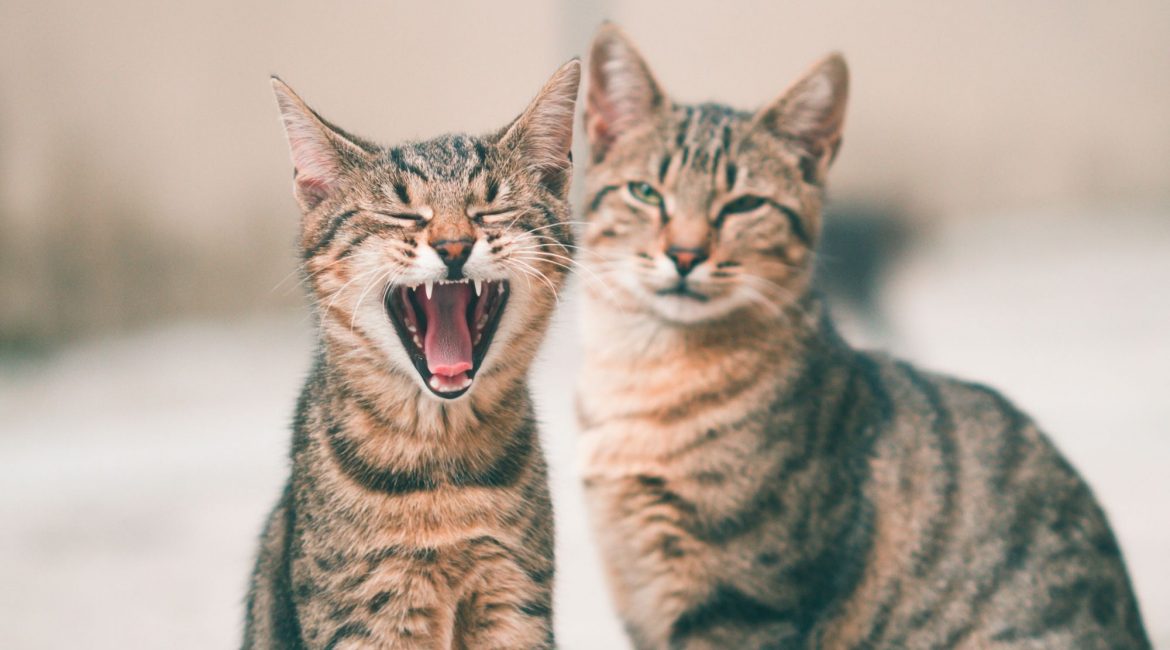Domestic cats have nailed the perfect meow to let their owners know what they want. As you get to know your cat, you will learn which meow means they want to be fed, be let outside, or if they want some cuddles.
However, this cat-to-human communication differs from cat-to-cat communication. The way in which cats talk to each other is a bit more complicated. Want to learn more? Then read on:
One would expect their feline friend to communicate with other cats with a series of meows, as they do with their owners, however, cat language is made up of a lot more than a few meows. Cats communicate with each other through vocalisations, body language, chemical cues, and scents. Felines communicate with fast, subtle signals so it is easy for us humans to miss them.
Your cat has a lot to say, and here’s how you can learn to listen in on their conversation with their purrfect pals!
Kitty Cat Body Language
Your purring pet’s body language is an important communication tool when they are talking to their other four-legged friends. Cats use physical contact to display affection towards other felines. You may see Mitten touch noses or rub up against their feline friend when greeting each other, which shows that they are friendly and content with each other.
However, physical touch is one of many different ways that cats communicate through body language, here are a few more to watch out for:
1. Lying belly up
A cat showing their belly to their cat companion can mean one of two things: that they trust their fellow feline, or they are getting ready for a fight (we warned you that cat communication was complicated).
Unlike dogs who roll over and lie belly up when showing submission to other dogs, cats will show their belly to another cat if they are happy and comfortable. A cat’s vital organs are located in its soft belly and they are very protective of this area, so when a kitty cat rolls over it can communicate trust, comfort, and a willingness to be vulnerable to another cat.
However, it could mean quite the opposite too! Feral cats are seen rolling over into a defensive, fighting position. They use this posture as it gives them full use of their claws and teeth when fighting off predators. Cat communication is so complicated — we know!
2. A chatty feline tail
Cats wear their feelings on their tails. Your cat’s tail can tell you a lot about how they feel toward the other cat in the room. Here are some tail movements to watch out for:
- A tail standing straight up in the air shows that your cat is friendly and happy to interact.
- A slow-wagging tail means Mittens feels angry, upset, or aggressive.
- A tucked-in tail shows that your cat is feeling nervous or showing submission.
- A puffed-up tail shows that your cat is trying to make itself look as big as possible as they feel threatened by the other cat in the room.
3. Feline Vocal Communication
If you’re the proud owner of a feline, you will be well-accustomed to the loud meow in the middle of the night, calling to let them outside, or the constant meowing when they are ready for their food. Your purring pet will have mastered the perfect meow to let you know exactly what they want from you.
You may have even woken up to the terrible guttural meowing, screeching and hissing of two cats fighting in the middle of the night. When domestic cats communicate with each other, their sounds can include a range of purring, meowing, hissing, or growling.
Here’s what some of the vocalisations mean:
- Loud meowing or hissing: this displays feelings of anxiety or fear.
- Calm, less intense meowing and purring: this shows that your cat is confident and content in the company of its purrfect pal.
- Low growling: this represents a warning that your cat feels threatened and fearful in the presence of the other cat and it is important to separate them at this point.
Unlike domestic cats, who have learned to use meowing as their way of talking to their owners, feral cats are usually silent, with the occasional hiss or purr.
Lastly, how feline friends communicate through smell
Cats are known to communicate through the scent of urine, chemicals, and pheromones produced in the glands throughout your pawsome pal’s body. This is one of the main tools in cat communication.
You may recall the pungent smell of cat urine, it is certainly a smell you aren’t likely to miss! Cats spray their urine as a way of communicating their dominance and marking their territory. In addition to this smelly way of talking cats use pheromones to communicate several things, such as:
- announcing reproductive status
- showing aggression: this is dominant in cats so be sure to have affordable pet insurance as they tend to get into fights more often than not
- defining territory: cats will scratch objects to mark their territory and leave behind pheromones from the scent glands in the paw pad
- creating familiarity and bonds: when you see two cats running their heads together, they are likely releasing pheromones from the scent glands around their mouth and cheeks which communicates comfort and trust towards each other.
Just remember that there are always two sides to cat communication and might not be obvious to the untrained eye.
Now, you have learned the basics about cat communication and can finally be a fly on the wall to your cat’s conversations with their feline friends
Yours in insurance you could cuddle,
Oneplan




